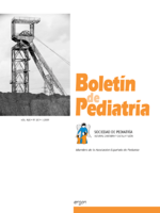Análisis de algunas propiedades psicométricas de la batería Luria-Inicial en una muestra de escolares potosinos
E. Bausela Herreras , C. Isis Orozco
Bol. Pediatr. 2009; 49 (207): 35 - 40
Introducción: En México, se han realizado algunos intentos previos para obtener datos normativos de niños de diversas edades en diversas pruebas de evaluación neuropsicológica estos estudios no han sido suficientes para disponer de datos normativos representativos de la diversidad cultural característica de la Republica Mexicana, y en concreto dirigido a personas que presentan algún tipo de afectación cognitiva. Objetivos: Esta investigación forma parte de la línea de investigación que tiene como finalidad contribuir al proceso de validación de la batería neuropsicológica Luria- Inicial en población mexicana. En este artículos nos vamos a centrar en analizar algunas propiedades psicométricas de la batería Luria-Inicial. Muestra: La muestra generadora de datos son 100 niños/as de preescolar y primer grado de primaria, con edades comprendidas entre los 4 y 6 años, de ambos sexos. Instrumentos: Dos fueron los instrumentos aplicados: Batería Neuropsicología Infantil (Luria-Inicial) y el Test de Matrices Progresivas de Raven. Resultados: El primer paso en el análisis fue obtener la consistencia interna global de la batería Luria-Inicial a través del Coeficiente Alfa de Cronbach, obteniéndose un valor de 0,861, ligeramente inferior al obtenido en el proceso de validación. Respecto al análisis de la estructura interna de la batería Luria-Inicial se obtuvieron cuatro factores que explican el 68,521% de la varianza total. Conclusiones: La batería Luria-Inicial ha mostrado tener buena consistencia interna en su totalidad analizada en subtests y áreas. Por lo que se refiere a la estructura factorial, coinciden en número, discrepan en cuanto a su composición con los obtenidos con la muestra normalizada.
Analysis of some psychometric properties of the Luria-Initial battery in a sample of Potosino school children
Introduction: In Mexico, several previous attempts have been made to
obtain standardized data on children of different ages in different
neuropsychological evaluation tests. These studies have not been
sufficient to obtain standardized data representative of the cultural
diversity characteristic of the Mexican Republic and specifically aimed
at persons who have some type of cognitive dysfunction.
Objectives: This investigation forms a part of the investigational line
whose purpose is to contribute to the validation process of the
Initial-Luria neuropsychological battery in the Mexican population. In
these articles, we are going to focus on analyzing some psychometric
properties of the Luria-Initial battery.
Sample: The sample generating the data include 100 boys and girls of
pre-school and first grade, whose ages ranged from four to six years,
of both genders.
Instruments: Two were applied instruments: Child Neuropsychological Battery (Luria-Initial) and Raven Progressive Matrices Test.
Results: The first step in the analysis was to obtain the internal and
global consistency of the Luria-Initial battery using Cronbach's Alpha
Coefficient, obtaining a value of 0.861, slightly inferior to that of
that obtained in the validation procedure. Regarding the analyses of
the internal structure of the Luria-Initial battery, four factors were
obtained that accounted for 68.512% of the total variance.
Conclusions: All the Luria-Initial battery analyzed in subtests and
areas has been shown to have good internal consistence. In regards to
the factorial structure, they coincide in number, and disagree in
regards to their composition with those obtained with the standardized
sample.
Artículo completo (PDF) (78 kb.)
- Psicología
